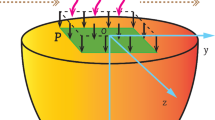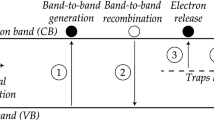Abstract
Problems of high-power microwaves penetrating into and reflecting from a semiconductor (silicon) plate with non-stationary processes are investigated. The plate is the basis of switches activated by laser-driven photoconductivity which changes its properties when heated by the switched microwave power. Analytical criteria for the stationary solutions of the activated (quasi-metallic) and deactivated (dielectric) states of the switch under the conditions of high-power microwave heating and external cooling are found. Results of numerical simulations are also given for the problems of the switch activation by microwave heating initiated by pulsed laser radiation, which increases the carrier density rapidly. Numerical simulations are carried out using the finite-difference time-domain method with the unsplit perfectly matched layer absorbing boundary conditions. We demonstrate various types of solutions depending on the basic parameters of the problems - microwave field intensity, laser pulse energy and semiconductor doping.








Similar content being viewed by others
References
T. Fumihiko and S. G. Tantawi, “Development of high power X-band semi-conductor microwave switch for pulse compression systems of future linear colliders,” Phys. Rev. Spec. Top., Accel. Beams 5, 062001 (2002).
W. Nunnally and D. Cooperstock, “Methods and Configurations for Improving Photo-Conductive Switch Performance,” Proc. of the 25th International Power Modulator Symposium 2002 and 2002 High-Voltage Workshop, 2002, pp.183-186.
A. A. Vikharev, G. G. Denisov et al., “A high-speed quasi-optical wave phase switch based on the induced photoconductivity effect in silicon,” Tech. Phys. Lett. 33 (9), 735–737 (2007).
A. Hangleiter, “Nonradiative recombination via deep impurity levels in silicon: Experiment,” Phys. Rev. B 35 (17), 9149–9161 (1987).
A. Hangleiter, “Nonradiative recombination via deep impurity levels in silicon: The excitonic Auger mechanism,” Phys. Rev. B 37 (5), 2594–2604 (1988).
O. Madelung, “Semiconductors, Data Handbook,” Springer, 2003.
A. Taflove, Computational electrodynamics: the finite-difference time-domain method (Boston MA, Artech House, 1995).
S. D. Gedney, “An anisotropic perfectly matched layer – absorbing me-dium for the truncation of FDTD lattices,” IEEE Trans. Antennas Propag. 44 (12), 1630–1639 (1996).
Acknowledgment
The authors thank V. Ya. Aleshkin for useful discussions.
Author information
Authors and Affiliations
Corresponding author
Rights and permissions
About this article
Cite this article
Kulygin, M.L., Denisov, G.G. & Kocharovsky, V.V. Modeling of Dynamic Effects in a Laser-Driven Semiconductor Switch of High-Power Microwaves. J Infrared Milli Terahz Waves 31, 31–40 (2010). https://doi.org/10.1007/s10762-009-9557-8
Received:
Accepted:
Published:
Issue Date:
DOI: https://doi.org/10.1007/s10762-009-9557-8




